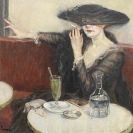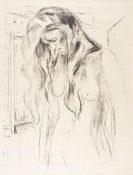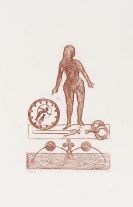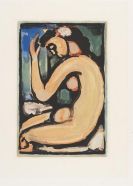
Pierre Bonnard
Fontenay-aux-Roses
1867 -
Le Cannet/Cannes
1947
Pierre Bonnard was born in Fontenay-aux-Roses, a town south-west of Paris, on October 13, 1867. At first he studies law at the Sorbonne in Paris from 1885 to 1888. He soon turns to painting and attends the École des Beaux-Arts and the Académie Julian as of 1888, which is where he gets to know Maurice Denis, Paul Sérusier and Edouard Vuillard, together they start the artists group "Les Nabis" (Hebrew: Prophets) in 1889. They gear their works at the art of Paul Gauguin, whose works they see in an exhibition at the Café Volpini. They are impressed by his emphasize on planarity, meaning the arrangement of colors on the surface, regardless of any accurate depiction of the object, with the focus on the artist's subjective emotions and imagination.
Pierre Bonnard's first one-man show takes place in the gallery of Paul Durand-Ruel in 1896. As of 1903 he regularly participates in exhibitions in the Paris Fall Salon. He begins to deal with the art of Japanese woodcuts, which takes him to a more decorative concept and to an organic-ornamental style, closely linking him with Art Nouveau.
Pierre Bonnard works as a painter, graphic artist, illustrator, poster designer, but he also makes furniture and stage designs. He makes numerous illustrations, mostly lithographs, for the magazine "La Revue Blanche". He is regarded as one of the precursors of modern European poster art. In 1891 he makes the poster "France Champagne". Pierre Bonnard's lithographs are published by Ambroise Vollard as of 1895. He illustrates Paul Verlaine's work "Parallèlement" in 1900, in 1902 he makes the lithographs for "Daphnis and Chloe".
Everyday Parisian street scenes supply him with the motifs of his paintings, with an eye for the small details. In 1900 he makes the painting "Street Traffic", which counts among the most characteristic for this period.
As of 1903 he exhibits in the newly found Salon d'Automne. His very own style does not begin to unfold after the breakup of "Nabis" in 1905. He attains a moree tense arrangement of his compositions and a smoother, warmer and lighter palette. His painting now comprises nudes, landscapes, still lifes and portraits. Numerous landscapes are made on his journeys to Holland, Belgium, Great Britain, Italy, Spain and North Africa, most of which he does as of 1907.
He marries in 1925, and moves to the town of Le Cannet in South France in 1926, which will remain his place of residence. In 1947 - shortly before his death - Bonnard completes the large mural "Saint Francis visiting the Sick" in the church of Assy. Pierre Bonnard dies in Le Cannet on January 23, 1947.
Would you like to sell a work by Pierre Bonnard?
Infos for seller






